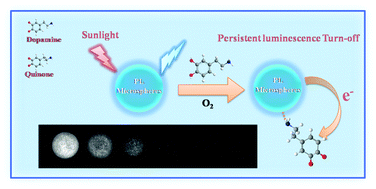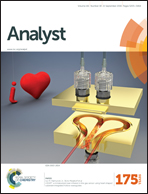A persistent luminescence microsphere-based probe for convenient imaging analysis of dopamine†
Abstract
Using probes based on persistent luminescence nanoparticles (PLNPs) is a promising methodology for direct imaging analysis of bio-molecules. In the present work, SrMgSi2O6:Eu0.01,Dy0.02 persistent luminescence microspheres have been synthesized via a simple template method and sunlight could successfully excite their luminescence. Further, a new probe was established based on turn-off of the persistent luminescence emission for detection and optical imaging of dopamine (DA). Mechanistic studies indicated that when the synthesized PL microspheres themselves are alkaline, the PL of the SrMgSi2O6:Eu0.01,Dy0.02 microspheres can be efficiently quenched by DA through electron transfer in the presence of ambient O2. The approach exhibited high convenience by only homogeneously mixing DA and the SrMgSi2O6:Eu0.01,Dy0.02 microspheres. Meanwhile, other phenols, ascorbic acid (AA), and uric acid (UA) were tested and had little interference to the dopamine detection. The current strategy showed the linear range of PL intensity versus concentration was 1.0 × 10−5–1.0 × 10−3 M for DA with a detection limit of 0.78 μM (S/N = 3) and it was successfully applied for imaging and detection of DA in human urine with quantitative recovery (99.6–102.5%).


 Please wait while we load your content...
Please wait while we load your content...